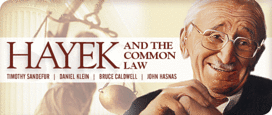Tim’s recent declarations for rationalism and idealism succinctly express his impetus against Hayek.
I think it’s misguided to think that there is Ethics, which tell us what is Right, and then there are “positive” understandings, to which we may then apply our ethical conclusions. I more see it as one big conversation, with ises and oughts naturally and tacitly interwoven and easily translated one into the other. So I can’t really enter in Tim’s mode of thought.
But in an important respect I second his stand for rationalism, and, correspondingly, some dissatisfaction with Hayek.
As I see it, we organize classical liberal thought as a web of statements. Those more central to the web may be called verities — important by-and-large truths.
The central verity of liberalism/libertarianism concerns the liberty principle, which says: In a choice between a dyad of policy reforms (one of which may be no reform at all), the reform that ranks higher in liberty is the more desirable.
The central verity of liberalism/libertarianism may be called the liberty maxim, which says: By and large, the liberty principle holds.
If Tim would drop the “by and large,” making the liberty principle the central verity of liberalism/libertarianism, then I think he’s mistaken.
But that aside, I, too, see the liberty principle as an analytic fulcrum and engine of inquiry. The liberty principle deserves the presumption, placing the burden of proof on the interventionists, even when they are defending the status quo. I favor that some — not all — liberals go on the offensive swinging the liberty principle at most anything standing in its way. I hazard to say that, in a significant way, Hayek thought so, too. He wasn’t one of those suited to proceeding in such fashion. But when Walter Block asked him to contribute a Foreword endorsing Block’s Defending the Undefendable, Hayek graciously did so and tipped his hat to Block’s regimen of “shock therapy.”
The approach — working off the liberty principle — is, however, often less patent and elementary than some think. In many areas of policy there are issues of disagreement between direct and overall liberty (for the distinction, see Klein and Clark, forthcoming). In those troublesome areas, if we define the liberty maxim in terms of direct liberty (which I think we usually do), the “by and large” qualification grows in significance. If we define it in terms of overall liberty, its application becomes much fuzzier. (Did bailing out the banks augment or reduce overall liberty? Did the United States pitching in against Hitler augment or reduce overall liberty?)
—-
Reference:
Klein, Daniel B. and Michael J. Clark. “Direct and Overall Liberty: Areas and Extent of Disagreement,” Mercatus Center Working Paper. Reason Papers, forthcoming.

